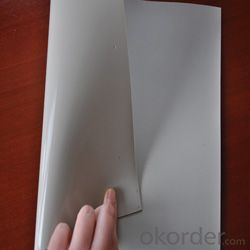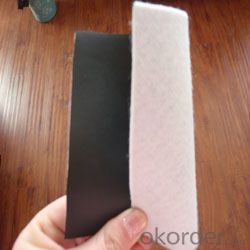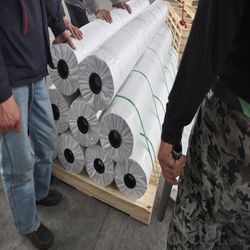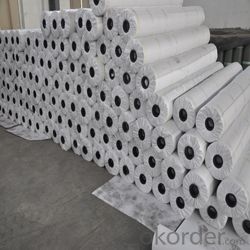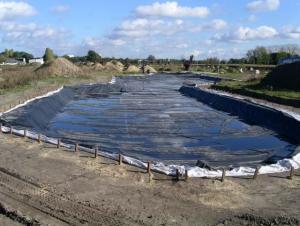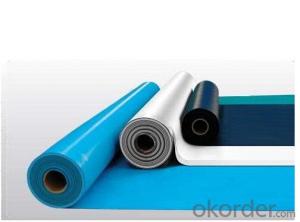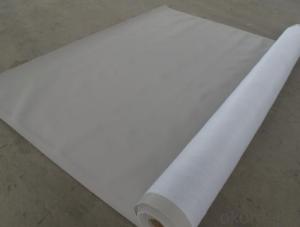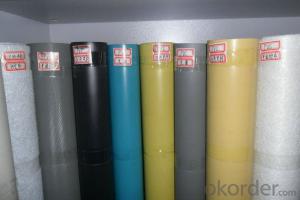PVC waterproof membrane
- Loading Port:
- Qingdao
- Payment Terms:
- TT OR LC
- Min Order Qty:
- -
- Supply Capability:
- 100000 m²/month
OKorder Service Pledge
OKorder Financial Service
You Might Also Like
PVC (polyvinyl chloride) roof membrane
is an excellent high quality polymer waterproof sheet, made of PVC resin by adding plasticizer,
anti-UV agent, anti aging agent, and stabilizer and other processing aids through extrusion
and molding.As the highly recommended product by the Ministry of Construction, it is featured by high tensile
strength, great elongation, good stability, small shrinkage, low temperature performances, good resistance to
weathering and root penetration, and long service life.
Physical Property:
1.Good combination of high elasticity and tensile strength.
2.Fine resistance to static electricity.
3.Excellent resistance to ageing / weathering.
4.Durable,the effective age can be more than 20 years used on exposed surfaces,used on non-exposed surfaces,it can reach 50 years.
5.Fine flexibility at low temperature,adaptable to cold conditions.
6.Root-resistance,can be used on the planting roofs.
7.Fine puncture resistance, joint peel strength and joint shear strength.
8.Fine UV-resistance,no pollution to environment.
9.Easily welding,installing,secure.
10.Easy treatments to the delicate parts of corners and edges.
11.Convenient maintenance with low cost.
Polyvinyl Chloride (PVC) membrane with fiber reinforced layer
on the back is widely used in the roofs of civil buildings,
tunnels, channels, subways, highways, planting roofs, the roofs of steel
frame structure buildings, and etc.
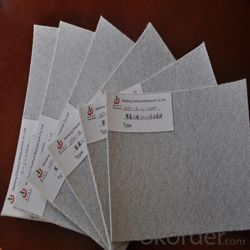
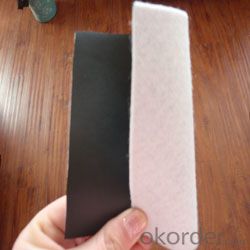
- Q: Are there different waterproofing membrane options for above-ground and below-ground applications?
- Yes, there are different waterproofing membrane options available for above-ground and below-ground applications. Above-ground applications typically involve waterproofing structures such as roofs, balconies, or walls. For these applications, commonly used waterproofing membrane options include liquid-applied membranes, sheet membranes, and polyurethane membranes. These membranes are designed to withstand exposure to weather elements such as UV rays, temperature changes, and foot traffic. On the other hand, below-ground applications involve waterproofing structures like basements, foundations, or tunnels. Below-ground waterproofing membranes are specifically designed to withstand hydrostatic pressure from the surrounding soil and groundwater. These membranes are typically thicker and more durable than above-ground membranes. Commonly used below-ground waterproofing options include bituminous membranes, bentonite clay membranes, and composite membranes. It is important to choose the right waterproofing membrane for each specific application as the requirements and challenges can vary. Consulting with a waterproofing professional or engineer can help determine the most suitable membrane option for both above-ground and below-ground applications.
- Q: SBs waterproof cold sticky how to do?
- 5, protective layer construction. In order to shield or reflect the sun's radiation, to extend the life of the waterproof layer of the membrane, in the waterproof layer is completed and checked after passing, should be coated on the surface of the waterproof layer of adhesive, side of the expansion of the expansion of silica powder protective layer, or uniform Brush the silver or green paint as a protective layer.
- Q: Can a waterproofing membrane be applied to roofing systems?
- Yes, a waterproofing membrane can be applied to roofing systems. It is a common practice to install a waterproofing membrane on flat or low-slope roofs to provide an additional layer of protection against water infiltration. This membrane helps to prevent leaks and extends the lifespan of the roofing system.
- Q: Can a waterproofing membrane be used on brass surfaces?
- No, a waterproofing membrane cannot be used on brass surfaces as it is typically designed for use on materials like concrete, wood, or metal but not specifically for brass.
- Q: Can a waterproofing membrane be used for tunnels and underground structures?
- Yes, a waterproofing membrane can be used for tunnels and underground structures. Waterproofing membranes are commonly used in construction to provide a barrier against water infiltration and protect structures from potential damage caused by water. In the case of tunnels and underground structures, where there is a higher risk of water ingress due to the surrounding soil and groundwater, waterproofing membranes are essential to ensure the integrity and longevity of the infrastructure. Waterproofing membranes for tunnels and underground structures are specifically designed to withstand the unique challenges posed by these environments. They are typically made of durable and flexible materials such as bitumen, PVC, or EPDM, which can effectively resist water pressure and provide long-lasting protection. Additionally, these membranes are often reinforced with various layers or fabrics to enhance their strength and resistance to puncture or tear. The application of waterproofing membranes in tunnels and underground structures involves a meticulous process. The surfaces that need to be waterproofed, such as the walls and floors, are thoroughly cleaned and prepared to ensure proper adhesion of the membrane. The membrane is then applied in multiple layers, ensuring complete coverage and a seamless seal. Special attention is given to critical areas such as joints, corners, and penetrations to prevent any potential weak points. By using a waterproofing membrane, tunnels and underground structures can be effectively protected from water intrusion, groundwater pressure, and potential damage caused by moisture. This helps to maintain the structural integrity of the infrastructure, prevent water-related problems such as leaks, corrosion, or deterioration, and ensure the safety and functionality of the tunnel or underground facility.
- Q: Can waterproofing membranes be used on metal flashing?
- Waterproofing membranes have the capability to be utilized on metal flashing. These versatile membranes can be employed on various surfaces, including metal. Metal flashing is frequently utilized in construction to safeguard against water damage by diverting water away from vulnerable areas like roofs, windows, and doors. Adding a waterproofing membrane to the metal flashing provides an extra layer of defense against water infiltration, ensuring the flashing remains watertight and prevents any leaks or water damage. Furthermore, waterproofing membranes are usually flexible and can adhere to different surfaces, such as metal, making application easy and waterproofing effective.
- Q: Are there different waterproofing membrane options for above-ground and below-ground applications?
- There is a variety of waterproofing membrane options available for above-ground and below-ground applications. When it comes to above-ground applications, structures like roofs, balconies, or walls require waterproofing. In these cases, commonly used membrane options include liquid-applied membranes, sheet membranes, and polyurethane membranes. These membranes are designed to withstand weather elements, such as UV rays, temperature changes, and foot traffic. On the other hand, below-ground applications involve waterproofing structures like basements, foundations, or tunnels. Below-ground waterproofing membranes are specifically designed to withstand hydrostatic pressure from the surrounding soil and groundwater. These membranes are typically thicker and more durable compared to above-ground membranes. Bituminous membranes, bentonite clay membranes, and composite membranes are commonly used options for below-ground waterproofing. Selecting the appropriate waterproofing membrane for each specific application is crucial due to varying requirements and challenges. Seeking advice from a waterproofing professional or engineer can assist in determining the most suitable membrane option for both above-ground and below-ground applications.
- Q: About asphalt waterproofing membrane
- 4, SBS membrane is commonly referred to as a polymer modified asphalt coil, there are other APP, APAO and other modified asphalt membrane.
- Q: Can a waterproofing membrane be used on precast wood surfaces?
- Indeed, precast wood surfaces can benefit from the utilization of a waterproofing membrane. It is widely practiced to employ waterproofing membranes to shield diverse surfaces, such as wood, against water-related harm. These membranes are engineered with the purpose of establishing a barrier that obstructs the infiltration of water, thereby averting any potential structural problems or wood decay. By administering a waterproofing membrane to precast wood surfaces, one can successfully safeguard the wood from moisture and extend its durability. Nevertheless, it is crucial to verify the compatibility of the membrane with wood and adhere to the manufacturer's instructions for application in order to attain optimal outcomes.
- Q: Can a waterproofing membrane be used for roofing applications?
- Yes, a waterproofing membrane can be used for roofing applications. Waterproofing membranes are specifically designed to prevent water infiltration, making them ideal for protecting roofs from leaks and water damage. They provide a durable and effective barrier against moisture, ensuring the roof remains watertight.
Send your message to us
PVC waterproof membrane
- Loading Port:
- Qingdao
- Payment Terms:
- TT OR LC
- Min Order Qty:
- -
- Supply Capability:
- 100000 m²/month
OKorder Service Pledge
OKorder Financial Service
Similar products
Hot products
Hot Searches
Related keywords








